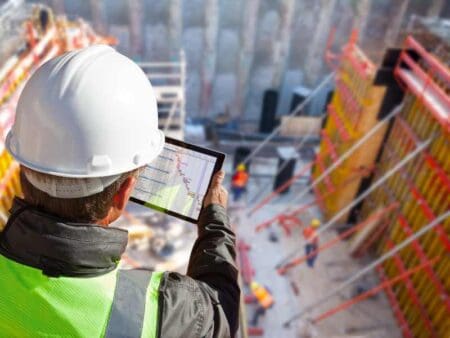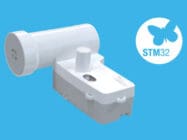
More sustainable and digital: The construction and real estate industry is on the verge of substantial changes. But what will the future of construction and building operations look like?
Siemens Smart Infrastructure has identified seven trends that show where the journey is headed.
By Michael Kiy, director of innovation management, Siemens Smart Infrastructure
1. Digital building design
Many modern buildings are already being built twice – first on the computer, and then in the physical world. The magic word that has pushed open the door to the future of building design is Building Information Modeling (BIM), a type of computer-aided design (CAD) for buildings.
Digital design using BIM gives building owners much more control over their project. Thanks to BIM, they can do a virtual walk-through of their building during the design stage. This is made possible by a detailed virtual model of the building, a “digital twin,” based on the BIM data.
The virtual model allows building owners to assess implementation variants in 3D and provide feedback. They can also take financial factors into account because the costs of each design measure are stored in the digital twin. As a result, it is easy to see how a particular change will affect the price.
Based on feedback from the owner and other stakeholders, the designers make adjustments to the project, which can then be reviewed again. These iteration cycles are short and cost-efficient because algorithms take a lot of the work out of the hands of the designers. If, for example, the room size is reduced when designing a hospital, an algorithm automatically adjusts the walls in the virtual model based on predefined criteria.
The same applies to other details, such as the number and position of fire detectors. This makes planning more reliable and efficient. The digital twin allows for transparent design across disciplines. This helps avoid errors, optimally coordinate disciplines, and provide up-to-date cost information at all times. This trend will become more pronounced, making building design not only more transparent, but also more efficient and cost-effective.
2. Collaboration in the digital twin
For digital design to deliver its benefits, the stakeholders involved in construction must share their data. Only then can transparency be established across the entire design and construction process.
In modern software development, these processes are modelled on platforms such as Github or Gitlab which allow multiple programmers to collaborate on a project. The software manages all inputs, and all changes are visible to everyone.
However, the construction industry is not there yet. Many stakeholders still work with disconnected two-dimensional plans or move the BIM data to other systems, leading to major adjustment losses. The desired transparency over the entire design process is currently still a pipe dream.
In addition, it remains to be seen how this new approach can be used to offset expenses if stakeholders design their disciplines in collaboration with others. New approaches are needed. For example, the building owner who benefits from the digital twin during operational optimisation could compensate the designers who created it for this added value.
3. Digital project management
When the digital building twin is in place, the next question is in which steps the physical building will be constructed. Today, the project planners determine the sequence. It is based on experience, is usually imprecise, and is difficult to adjust if delays occur in a substep.
Digitalisation promises dramatic improvements for project management. For example, the US company Alice Technologies is working on completely automating this process. The computer learns the ideal sequence of project steps and uses BIM data to create project plans on its own. They can be updated instantaneously if delays occur somewhere. This ensures that the best possible sequence is selected. According to the company, this solution can already save an average of 11% of costs and 17% of time during construction.
In the future, computer-aided project management is likely to become even more refined. This, in turn, could change the way contracts are awarded for construction projects: In this way, even small project steps, like installing room devices such as thermostats, could be put out to tender via an app as work packages at a predefined price – similar to the way Uber offers trips to its drivers. This would also give small local installers an opportunity to participate in construction projects. In addition, quality assurance could be performed through reviews and feedback in such an app.

Join Enlit Europe in Frankfurt and be part of the conversation about the energy transition in Europe and beyond.
4. Building while conserving resources
The construction of buildings is resource-intensive and anything but climate-friendly: Each year, approximately 4.4 billion tons of cement are produced, releasing roughly as much CO2 as 700 coal-fired power stations.
In order to reduce the environmental footprint of buildings and infrastructures, it is crucial to use building materials sustainably. First, more building materials need to be recycled. To some extent, this is already being done today. For example, an existing concrete shell is no longer demolished and rebuilt, but incorporated into the design of the new building or reused as fill material. Secondly, more climate-friendly alternative building materials such as wood should be used more widely.
New technologies can also make construction more resource-efficient. For example, 3D printing promises not only more efficient processes, but also a massive reduction in the environmental footprint, because additive manufacturing can be used to print new shapes that use less construction material without compromising stability.
5. Robots on the construction site
Another trend that can already be seen today is the use of robots: Drilling robots from Schindler or Hilti, for example, are already in use, independently drilling holes in concrete according to data specifications. In addition, robots are already being used to manufacture complex structures from alternative building materials.
Increased cost pressure will lead to more industrial construction. Using new digital manufacturing methods, components will be produced individually and on demand. Since more elements will be integrated into prefabricated products – electrical components, for example – the construction site of the future will increasingly focus on assembling prefabricated elements.
Have you read:
E.ON launches digital business to manage grid complexity
Sharper Shape digital twin tech expands with remote sensing acquisition
Kadri Simson says quicker permitting and digitalisation will ease energy crisis
6. Data-based building operation
Heating, cooling and domestic hot water require the most energy during the building’s operational phase. A smart building of the future will have sensors and intelligent controls to make the operation of building equipment as efficient as possible. It will also take the behaviour and needs of the building occupants into account: There is, for instance, no need for heating in unoccupied spaces. The smart building incorporates weather forecasts and the availability of renewable energy – for example from the PV system on the roof – into its behaviour.
The data collected in the smart building can be analysed by algorithms to optimise building management: When deviations occur, facility management is informed so that they can decide what to do. The data will be available in a standardised form, and there will be applications that process the data and offer added value, such as energy savings. These applications can be available in a virtual marketplace and customers will be able to select those that best serve their purposes.
7. Electric vehicles as power storage
In smart buildings, energy storage will have a larger role than it does today. Electric vehicles will play an important part: During the day, when they are parked at work, they receive for instance solar power and are charged. The stored power can then be used at home in the evening. Smart systems ensure that the battery still has enough of a charge to drive back to work the next day. If the calendar shows a meeting further away, the discharge of power from the vehicle’s batteries will be stopped earlier so that the destination can be reached easily.
Connecting consumer and power generation data makes it possible to optimise the use of renewable energy and will play an important role in ensuring a sustainable energy supply. This type of energy optimisation will result in new business models. For example, excess power could be sold to a neighbour. However, such solutions currently face high bureaucratic and political hurdles.
Looking ahead
Although technologies and materials for a more sustainable and intelligent construction and real estate industry already exist, the road into the future of construction is rife with obstacles. Today, many companies see no incentive to actively drive change. Regulatory requirements and historically evolved structures partially impede progress. And as long as the cost pressure is not high enough, the automation of the construction industry will not move forward. In the long run, however, this will not be a viable approach. Progress and digitalisation will prevail, as examples from the printing, photography and music industry have clearly shown.
The good news: There are many ways to modernise the construction industry. Software developers, start-ups and advanced technologies can and will revolutionise many things – this is just the beginning.
ABOUT THE AUTHOR

Michael Kiy is director innovation management at Siemens Smart Infrastructure.
Since 2019, Kiy has been a member of the Expert Board of Electrosuisse and a member of the organizing committee of the Swiss Building Technology Congress as well as the Forum Smart Home.








